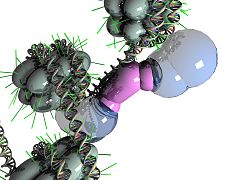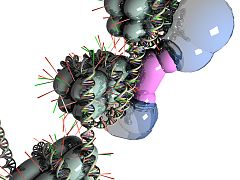Biology:RE1-silencing transcription factor
 Generic protein structure example |
RE1-Silencing Transcription factor (REST), also known as Neuron-Restrictive Silencer Factor (NRSF), is a protein which in humans is encoded by the REST gene, and acts as a transcriptional repressor.[1][2][3] REST is expressly involved in the repression of neural genes in non-neuronal cells.[3][4] Many genetic disorders have been tied to alterations in the REST expression pattern, including colon and small-cell lung carcinomas found with truncated versions of REST.[5] In addition to these cancers, defects in REST have also been attributed a role in Huntington Disease, neuroblastomas, and the effects of epileptic seizures and ischemia.
Function
This gene encodes a transcriptional repressor which represses neuronal genes in non-neuronal tissues. It is a member of the Kruppel-type zinc finger transcription factor family. It represses transcription by binding a DNA sequence element called the neuron-restrictive silencer element (NRSE, also known as RE1). The protein is also found in undifferentiated neuronal progenitor cells, and it is thought that this repressor may act as a master negative regulator of neurogenesis. Alternatively spliced transcript variants have been described; however, their full length nature has not been determined.[1] REST is found to be down-regulated in elderly people with Alzheimer's disease.[6]
REST contains 8 Cys2His2 zinc fingers and mediates gene repression by recruiting several chromatin-modifying enzymes.[7]
REST expression strongly correlates with increased longevity. REST levels are highest in the brains of people who lived up to be 90 - 100s and remained cognitively intact. Levels stayed high specifically in the brain regions vulnerable to Alzheimer's, suggesting that they might be protected from dementia. It is assumed that REST represses genes that promote cell death and Alzheimer's disease pathology, and induces the expression of stress response genes. Moreover, REST potently protects neurons from oxidative stress and amyloid β-protein toxicity.[6] REST is also responsible for ischaemia induced neuronal cell death, in mouse models of brain ischaemia. Ischaemia, which results from reduced blood perfusion of tissues, decreasing nutrient and oxygen supply, induces REST transcription and nuclear accumulation, leading to the epigenetic repression of neuronal genes leading to cell death.[8] The mechanism beyond REST induction in ischaemia, might be tightly linked to its oxygen-dependent nuclear translocation and repression of target genes in hypoxia (low oxygen) where REST fulfils the functions of a master regulator of gene repression in hypoxia.[9]
Interactions
RE1-silencing transcription factor has been shown to interact with RCOR1.[10]
References
- ↑ 1.0 1.1 "Entrez Gene: REST RE1-silencing transcription factor". https://www.ncbi.nlm.nih.gov/sites/entrez?Db=gene&Cmd=ShowDetailView&TermToSearch=5978.
- ↑ "The neuron-restrictive silencer factor (NRSF): a coordinate repressor of multiple neuron-specific genes". Science 267 (5202): 1360–3. March 1995. doi:10.1126/science.7871435. PMID 7871435. Bibcode: 1995Sci...267.1360S.
- ↑ 3.0 3.1 "REST: a mammalian silencer protein that restricts sodium channel gene expression to neurons". Cell 80 (6): 949–57. March 1995. doi:10.1016/0092-8674(95)90298-8. PMID 7697725.
- ↑ "Transcriptional regulation: cancer, neurons and the REST". Current Biology 15 (17): R665–8. September 2005. doi:10.1016/j.cub.2005.08.032. PMID 16139198.
- ↑ "A genetic screen for candidate tumor suppressors identifies REST". Cell 121 (6): 837–48. June 2005. doi:10.1016/j.cell.2005.03.033. PMID 15960972.
- ↑ 6.0 6.1 "REST and stress resistance in ageing and Alzheimer's disease". Nature 507 (7493): 448–54. March 2014. doi:10.1038/nature13163. PMID 24670762. Bibcode: 2014Natur.507..448L.
- ↑ "Chromatin crosstalk in development and disease: lessons from REST". Nature Reviews Genetics 8 (7): 544–54. July 2007. doi:10.1038/nrg2100. PMID 17572692.
- ↑ "Repressor element-1 silencing transcription factor (REST)-dependent epigenetic remodeling is critical to ischemia-induced neuronal death". Proceedings of the National Academy of Sciences of the United States of America 109 (16): E962–71. April 2012. doi:10.1073/pnas.1121568109. PMID 22371606.
- ↑ "REST is a hypoxia-responsive transcriptional repressor". Scientific Reports 6: 31355. 17 Aug 2016. doi:10.1038/srep31355. PMID 27531581. Bibcode: 2016NatSR...631355C.
- ↑ "CoREST: a functional corepressor required for regulation of neural-specific gene expression". Proceedings of the National Academy of Sciences of the United States of America 96 (17): 9873–8. August 1999. doi:10.1073/pnas.96.17.9873. PMID 10449787. Bibcode: 1999PNAS...96.9873A.
Further reading
- "Chromatin crosstalk in development and disease: lessons from REST". Nature Reviews Genetics 8 (7): 544–54. July 2007. doi:10.1038/nrg2100. PMID 17572692.
- "REST: a mammalian silencer protein that restricts sodium channel gene expression to neurons". Cell 80 (6): 949–57. March 1995. doi:10.1016/0092-8674(95)90298-8. PMID 7697725.
- "The neuron-restrictive silencer factor (NRSF): a coordinate repressor of multiple neuron-specific genes". Science 267 (5202): 1360–3. March 1995. doi:10.1126/science.7871435. PMID 7871435. Bibcode: 1995Sci...267.1360S.
- "A zinc finger protein that represses transcription of the human MHC class II gene, DPA". Journal of Immunology 156 (4): 1448–57. February 1996. doi:10.4049/jimmunol.156.4.1448. PMID 8568247.
- "Transcriptional regulation: cancer, neurons and the REST". Current Biology 15 (17): R665–8. September 2005. doi:10.1016/j.cub.2005.08.032. PMID 16139198.
- "Biological activity and modular structure of RE-1-silencing transcription factor (REST), a repressor of neuronal genes". The Journal of Biological Chemistry 273 (41): 26891–9. October 1998. doi:10.1074/jbc.273.41.26891. PMID 9756936.
- "CoREST: a functional corepressor required for regulation of neural-specific gene expression". Proceedings of the National Academy of Sciences of the United States of America 96 (17): 9873–8. August 1999. doi:10.1073/pnas.96.17.9873. PMID 10449787. Bibcode: 1999PNAS...96.9873A.
- "Neuron-specific splicing of zinc finger transcription factor REST/NRSF/XBR is frequent in neuroblastomas and conserved in human, mouse and rat". Brain Research. Molecular Brain Research 72 (1): 30–9. September 1999. doi:10.1016/S0169-328X(99)00196-5. PMID 10521596.
- "Neural restrictive silencer factor recruits mSin3 and histone deacetylase complex to repress neuron-specific target genes". Proceedings of the National Academy of Sciences of the United States of America 96 (24): 13691–6. November 1999. doi:10.1073/pnas.96.24.13691. PMID 10570134. Bibcode: 1999PNAS...9613691N.
- "The co-repressor mSin3A is a functional component of the REST-CoREST repressor complex". The Journal of Biological Chemistry 275 (13): 9461–7. March 2000. doi:10.1074/jbc.275.13.9461. PMID 10734093.
- "A splice variant of the neuron-restrictive silencer factor repressor is expressed in small cell lung cancer: a potential role in derepression of neuroendocrine genes and a useful clinical marker". Cancer Research 60 (7): 1840–4. April 2000. PMID 10766169.
- "Cell-type non-selective transcription of mouse and human genes encoding neural-restrictive silencer factor". Brain Research. Molecular Brain Research 90 (2): 174–86. June 2001. doi:10.1016/S0169-328X(01)00107-3. PMID 11406295.
- "REST repression of neuronal genes requires components of the hSWI.SNF complex". The Journal of Biological Chemistry 277 (43): 41038–45. October 2002. doi:10.1074/jbc.M205691200. PMID 12192000.
- "Corepressor-dependent silencing of chromosomal regions encoding neuronal genes". Science 298 (5599): 1747–52. November 2002. doi:10.1126/science.1076469. PMID 12399542. Bibcode: 2002Sci...298.1747L.
- "RE-1 silencing transcription factor (REST) regulates human synaptophysin gene transcription through an intronic sequence-specific DNA-binding site". European Journal of Biochemistry 270 (1): 2–9. January 2003. doi:10.1046/j.1432-1033.2003.03360.x. PMID 12492469.
- "Regulation of cholinergic gene expression by the neuron restrictive silencer factor/repressor element-1 silencing transcription factor". Life Sciences 72 (18–19): 2021–8. March 2003. doi:10.1016/S0024-3205(03)00065-1. PMID 12628452.
- "Regulation of Pax4 paired homeodomain gene by neuron-restrictive silencer factor". The Journal of Biological Chemistry 278 (37): 35057–62. September 2003. doi:10.1074/jbc.M305891200. PMID 12829700.
- "Huntingtin interacts with REST/NRSF to modulate the transcription of NRSE-controlled neuronal genes". Nature Genetics 35 (1): 76–83. September 2003. doi:10.1038/ng1219. PMID 12881722.
- "Critical role of the transcriptional repressor neuron-restrictive silencer factor in the specific control of connexin36 in insulin-producing cell lines". The Journal of Biological Chemistry 278 (52): 53082–9. December 2003. doi:10.1074/jbc.M306861200. PMID 14565956.
- "NRSF regulates the fetal cardiac gene program and maintains normal cardiac structure and function". The EMBO Journal 22 (23): 6310–21. December 2003. doi:10.1093/emboj/cdg601. PMID 14633990.
- "A small modulatory dsRNA specifies the fate of adult neural stem cells". Cell 116 (6): 779–93. March 2004. doi:10.1016/S0092-8674(04)00248-X. PMID 15035981.
- "Regulation of lifespan by neural excitation and REST". Nature 574 (7778): 359–364. October 2019. doi:10.1038/s41586-019-1647-8. PMID 31619788. Bibcode: 2019Natur.574..359Z.
External links
- REST+protein,+human at the US National Library of Medicine Medical Subject Headings (MeSH)
- FactorBook NRSF
This article incorporates text from the United States National Library of Medicine, which is in the public domain.
 |



